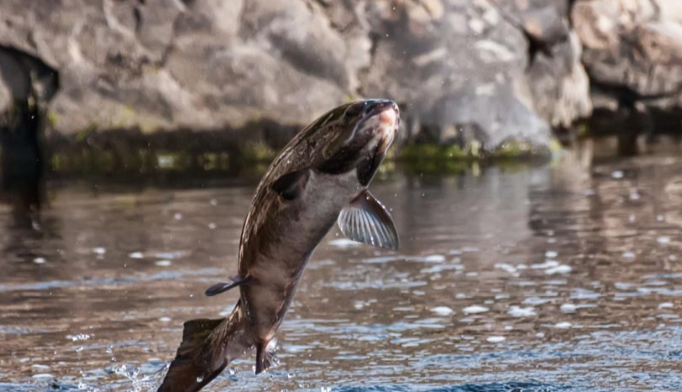Dawn Purchase, Aquaculture Programme Manager at the Marine Conservation Society considers if blue aquaculture can be the green protein of the future
Aquaculture, the farming of species in water, has been around for over 2,000 years. First started in earthen ponds in China to produce carp, it now accounts for about half of the seafood we eat globally. China remains the biggest aquaculture producer in the world, and carp is the most popular farmed fish by volume.
Aquaculture in the UK
Aquaculture remains the fastest growing food sector with an average annual increase in production of 5.3 % per year between 2001-2018. Globally in 2018, 114.5 million tonnes of aquaculture products, including aquatic animals, algae and ornamental seashells and pearls, with a farm gate value of $263.6 billion were produced (1). Atlantic salmon dominates UK aquaculture, produced in Scotland just under 204,000 tonnes of salmon was farmed in 2019 (2), the highest figure ever produced. Other finfish, mainly rainbow trout and halibut, are farmed in the UK, but in much lower numbers than salmon. Shellfish is also farmed, predominantly mussels, but also oysters, clams and scallops.
The Scottish salmon farming sector has been making continuous improvements to become more efficient and reduce its impact on the environment. Changes in feed formulations have reduced the reliance on wild capture ingredients, antibiotic usage has been largely replaced with the use of vaccines and technical innovations with equipment allow for constant feed monitoring, reducing waste and benthic impacts. Despite this progress, there remain a number of environmental concerns, as the industry continues to grow – and is not showing any signs of slowing down – it is important these issues be addressed before the industry expands further.
The problem of sea lice (small ectoparasites that attach to the salmon and feed on skin and mucus, compromising fish health), remains one of the biggest challenges for salmon farming, not only for the salmon but also for the wider environment, as sea lice can transfer to nearby wild salmon and trout. The chemicals used to treat sea lice can have impacts on adjacent crustacean species. Recently wrasse and lumpfish have been used to actually eat the lice off the farmed salmon, but there are concerns about the reliance on poorly managed wild stocks of these to fulfil the high demand.
Sustainability of fish feed
The sustainability of fish feed used in aquaculture is another key concern, of global significance. Many of the farmed fish we eat in the UK is imported, including firm favourites such as warmwater prawns, bass, bream and pangasius. These, as well as salmon, rely on commercial feed, utilising a range of ingredients, including wild fish such as anchovy, sprat, blue whiting, as well as vegetable proteins and oils such as soya and rapeseed oil. These ‘feed fisheries’ are amongst the largest fisheries in the world, but these species play incredibly important roles in the marine ecosystem, therefore, need to be well managed so as not to impact dependant species such as seabirds, and some can certainly be better managed to achieve this. There is also increasing concern about the environmental impacts of the terrestrial ingredients used, such as soya.
Feeding the world, looking to the oceans
Meanwhile, the global human population continues to grow, estimates vary, but by 2050, we can expect to see the global population reach over 9.5 billion people. According to the Food and Agriculture Organisation of the United Nations (FAO), 33% of the world’s farmland are moderately to highly degraded, which, in turn, impedes food security, particularly as much of the remaining land is unsuitable for agriculture. (3)
Given these constraints on agriculture to fulfil our current and future food needs, we need to look to the oceans to provide us with the protein we need. Global per capita seafood consumption has been steadily rising from 9.0kg in 1961 to 20.3kg in 2017 (1), with wild capture fisheries at their maximum capacity, aquaculture, particularly in the sea, offers the potential to fulfil the protein needs of a growing population. However, to enable this potential to be fulfilled it is increasingly clear that it needs to happen in a low carbon, climate-resilient and ecologically sustainable way.
Aquaculture: Climate-driven challenges
There are a number of climate-driven challenges that need to be overcome for us to realise the potential of aquaculture, predominantly ocean acidification, warming waters and increasing storm events. We need to look for species that can deal with the changing climate whilst still providing us with the food we need, with the lowest possible environmental footprint. Shellfish are a great example. As filter feeders, they don’t require commercial feed and remove nutrients from the surrounding water, but with a calcium carbonate shell, they also provide a carbon sink. Seaweed farming is also another emerging opportunity for “green” aquaculture. It requires minimum input, can store carbon, and dampens wave energy along our coastlines helping to protect our inshore waters.
Aquaculture holds huge potential to not only provide the protein a growing population needs but to do so in a low carbon ecological sustainable way. To realise this potential, we need to ensure it works in harmony with the environment on which it relies and encourage and support innovation to ensure blue aquaculture really does have a green future.
(1) FAO. The State of World Fisheries and Aquaculture. 2020. Available online at: http://www.fao.org/documents/card/en/c/ca9229en
(2) Marine Scotland. Scottish Fish Farm Production Survey. 2019. Available online at: https://www.gov.scot/publications/scottish-fish-farm-production-survey-2019/
(3) FAO. 2017. The future of food and agriculture – Trends and challenges. Rome.











